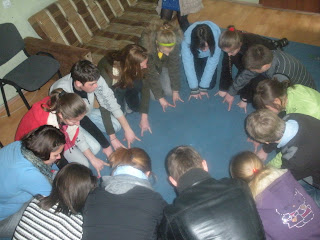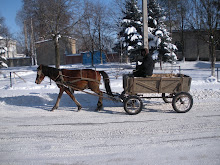Last fall, a number of my Peace Corps colleagues started asking questions about my youth council. What is a council? How is it different than a volunteer club? Can I come visit? Thus, we developed the following program to both educate Volunteers about the council model and provide a space for an experience exchange between two youth councils and the Peace Corps community.
The Guests

From the Peace Corps community, I first invited another Volunteer working with a Local Youth Council in a neighboring district. She and three of her most active council members came to help us convey the essence of the youth council model. In this picture, the visiting youth council is presenting our President with a medallion and pennant from their city.
Other Peace Corps guests included Volunteers working with civic education curriculum, and those interested possibly starting a youth council in their villages.
Part One: Youth Councils
In the first half of the program, both my youth council and the members of the visiting council discussed their activities. In true contemporary Moldvan fashion, each group presented picture slideshows of their favorite activities. My council also showed a short video, with a Mandy Moore song for a soundtrack that makes you...well....pray for it to end quickly.
As if anticipating the day's second act, I watched as the presentation to Peace Corps guests, about council activities, soon turn into a series of discussions between the two councils about how each group pulled-off their respective activities.
Lastly, my youth council presented their summer leadership course model, the best youth program I have seen in Moldova yet (credit to a previous Volunteer, not me). This is an 8-week course taught by youth, for youth. Each year's graduates are given the chance to be trained as trainers for the next year, making it an incredibly sustainable event. Since the program's initial success via a small grant, the district and city councils continued to fund it annually, no questions asked, no grant applications.
Coffee Break
Almost every Moldovan event comes with a coffee break. Ours was very typical, instant coffee and tea made available with hot water from an electric kettle, cookies, chocolates, and pastries.
Naturally, as the group migrated to coffee break, it settled into three distinct communities: my youth council on the couch, the visiting council at one end of the table, and Peace Corps Volunteers at the other. But, since I happen to work with the best youth around, Victor volunteered to provide a mixer, resulting in the activity shown above, mixing the participants and providing an opportunity to present a united presence via a perfect circle.
Part Two: Experience Exchange
The goal of part two was to generate as many ideas as possible. Additionally, since the Peace Corps guest learned so much from the youth in part one, this was a way for them to give back a little, and provide examples from their own experience in clubs and organizations.
Using a very simple rendition of the
Open Space Technology, we brained stormed a list of topics, chose three (recruiting volunteers, maintaining and motivating volunteers, and promoting youth talent), and divided into small groups.I loved watching these small group discussions. Frequently, expressions of intimidation (upon hearing about another's success) turned to curiosity, and finally enthusiasm crossed the faces of those most engaged in the discussions.
After 20 minutes of sharing experiences and ideas, each group reported their notes (which each participant will receive an electronic copy of), and we closed the day with our Local Youth Council secret clap, the one we use to finish every event at our council. Though, I guess that gave away our secret...










































